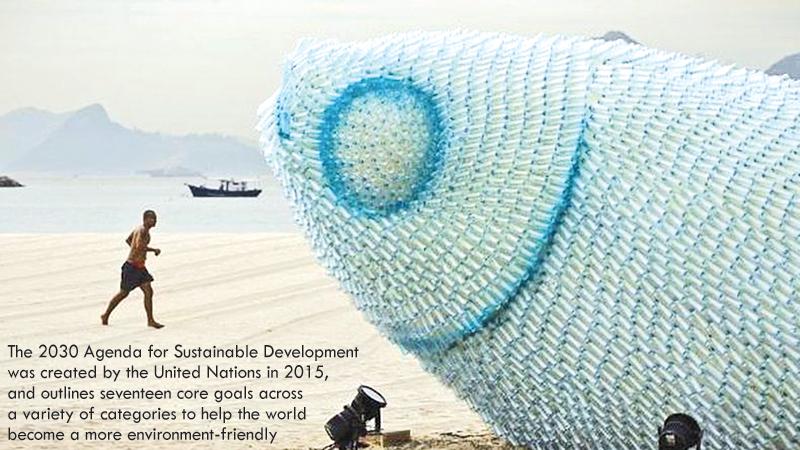
As our culture takes on more social responsibility and action, creative fields such as architecture, sculpture, and other various art forms have followed suit.
Artists hoping to join in on the current conversation surrounding sustainability are using their work to send a message, either by its theme or the media used to create the piece.
In 1983, to encourage global cooperation toward sustainable practices that benefit both the economy and the environment, the United Nations established the World Commission on Environment and Development.
This group, now known as the Brundtland Commission, first worked to define sustainable development and art, creating the 1987 guidelines that have been used to anchor environmentally conscious decisions in a variety of industries in the decades since:
Artists embraced this definition as a means to understand their individual impact on the environment. The idea of sustainability in art has led to groundbreaking works that leverage unique media and send powerful messages about climate change, political policy, and social injustice.
It is through sustainable art that artists hope to not only change how their work is made, but to inspire social and cultural change as well. But just how has this definition taken on new meaning in recent years? How are artists and institutions alike transforming the way that art is created?
Sustainability and art
 When it comes to art, the term “sustainability” takes on many meanings, and public opinion on this social and economic movement has expanded dramatically in the past few decades. And while the Brundtland Commission was an important first step toward fundamental change, policies and regulations aimed at reinforcing sustainable practices have continued to evolve in the years since to reward those who follow sustainable practices and encourage adoption.
When it comes to art, the term “sustainability” takes on many meanings, and public opinion on this social and economic movement has expanded dramatically in the past few decades. And while the Brundtland Commission was an important first step toward fundamental change, policies and regulations aimed at reinforcing sustainable practices have continued to evolve in the years since to reward those who follow sustainable practices and encourage adoption.
The 2030 Agenda for Sustainable Development was created by the United Nations in 2015, and outlines seventeen core goals across a variety of categories to help the world become a more environment-friendly, peaceful, and prosperous place.
Most resonant with the art world is goal twelve, centered around responsible consumption and production. This goal requires companies to work towards environmentally conscious practices throughout every facet of their operations, and increase the use of natural materials within their products.
Many items in mass production are experiencing a manufacturing overhaul, forcing artists to re-evaluate the pillars of design to comply with this new mandate.
While the policies are evolving at a high level, the idea of sustainability is also impacting the daily lives and work produced by individual artists. Although sustainable art isn’t the most lucrative of fields, it is intended to provide perspective on the world in its current state, suggest potential solutions, and raise awareness for issues that artists are passionate about.
Social consciousness
While many artists are adopting increasingly eco-friendly practices, some cultures have been implementing these principles for centuries. In Japan for example, Furoshiki, the art of Japanese fabric folding, emerged in the Nara period (710-794) as a way to protect valuables in transit, but it has recently caught on as a sustainable and beautiful way to carry necessities and wrap gifts.
Japan has also been leading the movement of upcycling, or transforming broken or unused objects into something usable, since the 15th century. Kintsugi is the act of repairing broken pottery with gold, which encourages avoiding waste and embracing imperfection.
Both artforms have helped transform popular thought toward sustainability by honoring worn objects, and to cement Japanese art as a leader in the movement.
Outside of cultural movements, artists across the globe have taken on the idea of sustainable art in different ways. Some works, like John Sabraw’s Toxic Sludge paintings, use actual pieces of polluted earth as their media.
Others use more traditional materials to bring awareness to a particular issue, such as Paulo Grangeon’s 1,600 Pandas, which installed paper-mache sculptures in a highly visible public space to confront human impact on endangered species.
The work of Danish-Icelandic artist Olafur Eliasson epitomizes how artists use sustainable materials to underscore the danger of climate crisis. In his 2014 installation titled ‘Ice Watch’, the artist used large chunks of ice that had fallen off of a glacier as a call to action.
